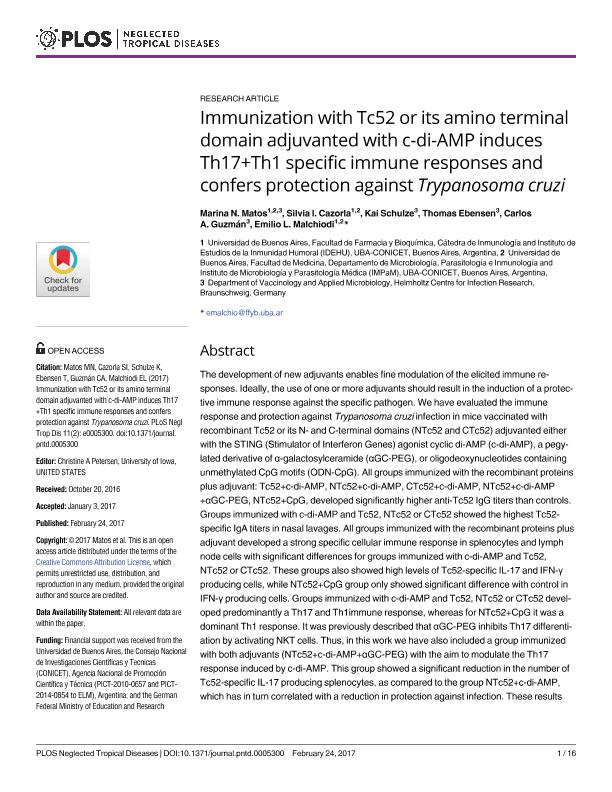Mostrar el registro sencillo del ítem
dc.contributor.author
Matos, Marina Nadia

dc.contributor.author
Cazorla, Silvia Ines

dc.contributor.author
Schulze, Kai
dc.contributor.author
Ebensen, Thomas
dc.contributor.author
Guzmán, Carlos A.
dc.contributor.author
Malchiodi, Emilio Luis

dc.date.available
2018-02-28T18:21:21Z
dc.date.issued
2017-02
dc.identifier.citation
Matos, Marina Nadia; Cazorla, Silvia Ines; Schulze, Kai; Ebensen, Thomas; Guzmán, Carlos A.; et al.; Immunization with Tc52 or its amino terminal domain adjuvanted with c-di-AMP induces Th17+Th1 specific immune responses and confers protection against Trypanosoma cruzi; Public Library of Science; PLoS Neglected Tropical Diseases; 11; 2; 2-2017; 1-16
dc.identifier.issn
1935-2735
dc.identifier.uri
http://hdl.handle.net/11336/37403
dc.description.abstract
The development of new adjuvants enables fine modulation of the elicited immune responses. Ideally, the use of one or more adjuvants should result in the induction of a protective immune response against the specific pathogen. We have evaluated the immune response and protection against Trypanosoma cruzi infection in mice vaccinated with recombinant Tc52 or its N- and C-terminal domains (NTc52 and CTc52) adjuvanted either with the STING (Stimulator of Interferon Genes) agonist cyclic di-AMP (c-di-AMP), a pegylated derivative of α-galactosylceramide (αGC-PEG), or oligodeoxynucleotides containing unmethylated CpG motifs (ODN-CpG). All groups immunized with the recombinant proteins plus adjuvant: Tc52+c-di-AMP, NTc52+c-di-AMP, CTc52+c-di-AMP, NTc52+c-di-AMP+αGC-PEG, NTc52+CpG, developed significantly higher anti-Tc52 IgG titers than controls. Groups immunized with c-di-AMP and Tc52, NTc52 or CTc52 showed the highest Tc52-specific IgA titers in nasal lavages. All groups immunized with the recombinant proteins plus adjuvant developed a strong specific cellular immune response in splenocytes and lymph node cells with significant differences for groups immunized with c-di-AMP and Tc52, NTc52 or CTc52. These groups also showed high levels of Tc52-specific IL-17 and IFN-γ producing cells, while NTc52+CpG group only showed significant difference with control in IFN-γ producing cells. Groups immunized with c-di-AMP and Tc52, NTc52 or CTc52 developed predominantly a Th17 and Th1immune response, whereas for NTc52+CpG it was a dominant Th1 response. It was previously described that αGC-PEG inhibits Th17 differentiation by activating NKT cells. Thus, in this work we have also included a group immunized with both adjuvants (NTc52+c-di-AMP+αGC-PEG) with the aim to modulate the Th17 response induced by c-di-AMP. This group showed a significant reduction in the number of Tc52-specific IL-17 producing splenocytes, as compared to the group NTc52+c-di-AMP, which has in turn correlated with a reduction in protection against infection. These results suggest that the Th17 immune response developed after immunizing with NTc52+c-di-AMP could have a protective role against T. cruzi infection. Groups NTc52+c-di-AMP, Tc52+c-di-AMP and NTc52PB, were the ones that showed better protection against infection with lower parasitemia and weight loss, and higher survival.
dc.format
application/pdf
dc.language.iso
eng
dc.publisher
Public Library of Science

dc.rights
info:eu-repo/semantics/openAccess
dc.rights.uri
https://creativecommons.org/licenses/by-nc-sa/2.5/ar/
dc.subject
Enfermedad de Chagas
dc.subject
Trypanosoma Cruzi
dc.subject
Vacuna
dc.subject
Tc52
dc.subject.classification
Enfermedades Infecciosas

dc.subject.classification
Ciencias de la Salud

dc.subject.classification
CIENCIAS MÉDICAS Y DE LA SALUD

dc.title
Immunization with Tc52 or its amino terminal domain adjuvanted with c-di-AMP induces Th17+Th1 specific immune responses and confers protection against Trypanosoma cruzi
dc.type
info:eu-repo/semantics/article
dc.type
info:ar-repo/semantics/artículo
dc.type
info:eu-repo/semantics/publishedVersion
dc.date.updated
2017-12-04T18:22:27Z
dc.journal.volume
11
dc.journal.number
2
dc.journal.pagination
1-16
dc.journal.pais
Estados Unidos

dc.journal.ciudad
San Francisco
dc.description.fil
Fil: Matos, Marina Nadia. Consejo Nacional de Investigaciones Científicas y Técnicas. Oficina de Coordinación Administrativa Houssay. Instituto de Estudios de la Inmunidad Humoral Prof. Ricardo A. Margni. Universidad de Buenos Aires. Facultad de Farmacia y Bioquímica. Instituto de Estudios de la Inmunidad Humoral Prof. Ricardo A. Margni; Argentina
dc.description.fil
Fil: Cazorla, Silvia Ines. Consejo Nacional de Investigaciones Científicas y Técnicas. Oficina de Coordinación Administrativa Houssay. Instituto de Estudios de la Inmunidad Humoral Prof. Ricardo A. Margni. Universidad de Buenos Aires. Facultad de Farmacia y Bioquímica. Instituto de Estudios de la Inmunidad Humoral Prof. Ricardo A. Margni; Argentina
dc.description.fil
Fil: Schulze, Kai. Helmholtz Centre for Infection Research; Alemania
dc.description.fil
Fil: Ebensen, Thomas. Helmholtz Centre for Infection Research; Alemania
dc.description.fil
Fil: Guzmán, Carlos A.. Helmholtz Centre for Infection Research; Alemania
dc.description.fil
Fil: Malchiodi, Emilio Luis. Consejo Nacional de Investigaciones Científicas y Técnicas. Oficina de Coordinación Administrativa Houssay. Instituto de Estudios de la Inmunidad Humoral Prof. Ricardo A. Margni. Universidad de Buenos Aires. Facultad de Farmacia y Bioquímica. Instituto de Estudios de la Inmunidad Humoral Prof. Ricardo A. Margni; Argentina
dc.journal.title
PLoS Neglected Tropical Diseases

dc.relation.alternativeid
info:eu-repo/semantics/altIdentifier/url/http://journals.plos.org/plosntds/article?id=10.1371/journal.pntd.0005300
dc.relation.alternativeid
info:eu-repo/semantics/altIdentifier/doi/http://dx.doi.org/10.1371/journal.pntd.0005300
Archivos asociados
